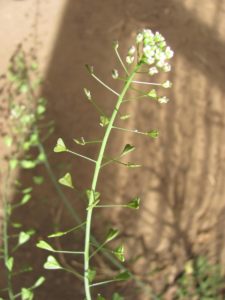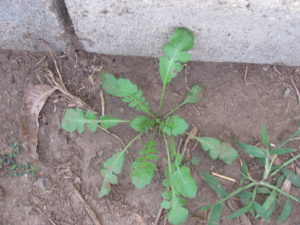
Botanical: Capsella bursa-pastoris
Table of Contents
Family: Brassicaceae
parts used: all, but especially aerial parts
energetics: drying, cooling
actions: antiscorbutic, astringent, diuretic, emmenagogue, hemostatic, hypotensive, oxytoxic, stimulant, vasoconstrictor, vasodilator, vulnerary
used for menstrual and urinary bleeding, labor, urinary tract infections, varicose veins
Shepherd’s Purse is so called from the resemblance of the flat seed-pouches of the plant to an old-fashioned common leather purse. It is similarly called in France Bourse de pasteur, and in Germany Hirtentasche. The Irish name of Clappedepouch was given in allusion to the begging of lepers, who stood at cross-roads with a bell or clapper, receiving their alms in a cup at the end of a long pole.
Lots of small birds love to eat the seeds. Chickens will (apparently) eat the whole plant, possibly affecting the color and taste of the eggs. Dairy cattle will also eat it, and this may affect the flavor of the milk. (my chickens eat it, I can’t tell!)
The seeds, aside from sticking to insects, are also reported to be toxic to mosquito larvae, and, when put in the water, may possibly help control mosquitos. Shepherd’s purse will also absorb excessive salts from the soil, and may be planted for that purpose.
Used in soil reclamation and as an insecticide. Shepherd’s purse was called “life protect plant” in China because it was thought to drive away mosquitoes. Indeed, the seeds (when placed in water) are reported to act as a sort of “fly-paper” for mosquitoes, reputedly attracting and trapping them. They are also said to secrete a substance toxic to mosquito larvae. A kilo of Capsella seeds is said to be capable of killing 10 million mosquito larvae. [3]
A single plant may produce a couple thousand seeds, and the seeds may remain viable for many years. So, to control this plant, pull it up before it goes to seed, and use mulch where possible, as the seeds remain dormant in the dark.
“Widespread, common… and always hard to find when you want some.” – Michael Moore
Culinary Use of Shepherd’s Purse
Shepherd’s purse is one of the earliest wild greens in the spring. In the early spring, before the flower stalks appear, the leaves are good in salads or cooked as greens. When the plant flowers, the larger basal leaves tend to die off, leaving only the smaller leaves clasping the stem. They’re still edible, but they get tougher, develop more flavor, and become labor-intensive to collect. Very high in Vitamin C!
Using Shepherd’s Purse for Wellness
Shepherd’s Purse is one of the most important medicinal plants of the Cruciferous family. It is a known staple for bleeding from uterine fibroids, post-partum, and perimenopause.
Medicinal Uses
Like many plants, shepherd’s purse is not just a good food source; it is also a useful addition to your medicine cabinet.
In fact, it has been used in both western and eastern medicine for centuries and is still popular among herbalists. Traditionally, shepherd’s purse has had several uses:
- It may help relieve diarrhea.
- Relief of cystitis symptoms.
- Calming stomach disorders.
- Treating sore throats.
- An effective laxative.
- Remedy for urinary tract infections.
These are all useful properties, but they are all just extra benefits on top of what shepherd’s purse is really good at – to stop bleeding.
This plant can be used to help heal wounds, stop bleeding from minor cuts, or treat menstrual bleeding and internal hemorrhaging. Scientists think this is because it contains a protein that mimics oxytocin, which stimulates the contraction of blood vessels.
To treat internal bleeding, shepherd’s purse can be taken in several ways. Here are the ones you can make at home:
Shepherd’s Purse Tincture
Collect and chop enough stalks and leaves to loosely fill a small mason jar. Cover the plant with alcohol – you can use vodka, Everclear or pharma grade vegetable glycerine. Then cap the jar and leave it in a warm place, out of direct sunlight, for four to six weeks. Finally, strain out the liquid and bottle it for future use.
This tincture can be taken internally – mix 20-30 drops into a glass of water twice a day. It can also be used to treat nosebleeds by dipping a cotton ball in it and inserting into the nostril.
Shepherd’s Purse Tea
Collect shepherd’s purse leaves, tie them in bunches and hang them up to dry. Once they’re dry, chop them roughly in a blender (a couple of seconds will do it) and store in an airtight container. Make the tea by infusing 1-2 teaspoons of the herb in hot water for ten to fifteen minutes. This can be drunk three to four times a day. If fresh plants are available they can also be chopped and used to make tea.
To treat external bleeding from small cuts and scrapes you can dip a cotton ball in the tincture and apply that directly to the wound.
In an emergency you can also put leaves directly on the wound; soldiers used shepherd’s purse this way in the First World War when supplies of other anti-bleeding drugs ran out.
Shepherd’s purse is a plant every self reliant soul should be able to recognize and use. It is both a nutritious food source and a valuable medicine.
Bushyhead Botanicals, to assure the best extract of Shepherd’s Purse’s active properties, hand-harvests only the flowering, above-ground parts of the plants, which are immediately extracted while still fresh and succulent. Our Shepherd’s Purse is never fumigated or irradiated.
To support wellness the whole plant in flower is used (except the roots) usually in the form of a tea or infusion. Either fresh or dried material may be used, but fresh is preferred as the dry material soon loses its medicinal properties. Shepherd’s purse is said to constrict the blood vessels (usually), lowers blood pressure (usually), and contracts the uterus. It is used during or after childbirth and to ease difficult menstruation.
“When you gather the seven herbs of spring, your spirit becomes gentle. And when you eat bracken shoots, osmund, and shepherd’s purse, you become calm. To calm restless, impatient feelings, shepherd’s purse is best of all. They say that if children eat shepherd’s purse, willow buds, or insects living in trees, this will cure violent crying tantrums, and in the old days, children were often made to eat them. Daikon (Japanese Radish) has for it’s ancestor the plant called Nazuna (shepherd’s purse), and this word Nazuna is related to the word nagomu, which means to be softened. Daikon is the “herb that softens one’s disposition.”
~Masanobu Fukuoka
Dose: Infusion: l-2 teaspoonfuls of the dried or fresh herb in a cup of water, 3 – 5 times a day. For menstrual problems, it should be taken beginning just before the period, every 2-3 hours. Fresh Plant, 1:2, recent Dry Plant, 1:5, 50% alcohol; 20-60 drops 3 – 5 times a day.
Safety:
- Never treat bleeding without first determining its cause
- Not recommended during pregnancy, the herb can cause uterine contractions. In Western medicine, oxytocin is used to induce labor, and Capsella is an oxytocin synergist [Michael Moore].
- GRAS
The Festival of Seven Herbs is a long-standing Japanese custom. The seven herbs of spring are watercress, shepherd’s purse, wild turnip, cottonweed, chickweed, wild radish, and bee nettle. A dish made with seven herbs (the seven herbs of spring), which are seri (Japanese parsley), nazuna (shepherd’s purse), gogyo (cotton weed), hakobe (common chickweed), hotoke no za (lamium amplexicaule), suzuna (turnip) and suzushiro (daikon radish), that are boiled, chopped and mixed into a rice porridge.

“This plant is a remarkable instance of the truth of an observation which there is too frequently room to make, namely, that Providence has made the most useful things most common, and for that reason we neglect them: few plants possess greater virtues than this, and yet it is utterly disregarded.”
– Culpeper’s Herbal, 17th century
References:
- Moore, Michael. 1989. Medicinal Plants of the Desert and Canyon West. Santa Fe: Museum of New Mexico Press.
- Leonard, David Bruce. (2016) Shepherd’s Purse. Retrieved November 05, 2016, from http://www.herbrally.com/monographs/shepherds-purse
- Allardice.P. A – Z of Companion Planting. Angus & Robertson 1993. Simple language, easy to read.
- Mowrey, Daniel B. 1986. The Scientific Validation of Herbal Medicine. McGraw-Hill Education; 1 edition (October 11, 1986)
- Ody, Penelope. 1993. The Complete Medicinal Herbal. New York: Dorling Kinnersley, Inc.
- EthnoPlants. (2016) Retrieved November 05, 2016, from https://phytochem.nal.usda.gov/phytochem/ethnoPlants/show/2288?qlookup=Capsella+bursa-pastoris&offset=0&max=20&et=E





